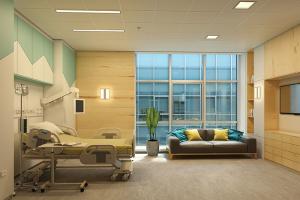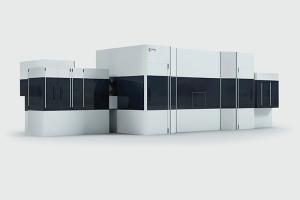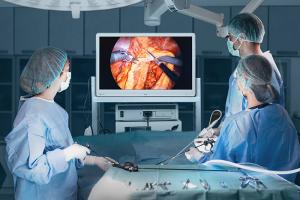RTLS solutions grow as operational tools

Image courtesy of Midmark
Real-time location systems (RTLSs), also known as real-time locating systems, continue to evolve to offer asset management, environmental monitoring and staff safety improvements for hospitals and other health care facilities.
RTLSs are being deployed across multiple facilities to track exit and entry points, inventory control levels based on patient capacity, and increase awareness of loss and theft prevention.
However, challenges abound. Hospitals are busy, complex work environments, with staff, assets and patients constantly in motion. The speed at which staff move, the proliferation of assets and the regular turnover of patients make hospitals one of the most challenging environments to cost-effectively equip with RTLSs.
“The biggest challenge to implementing RTLSs in hospitals lies in change management and harmonizing various working areas to come into the same digital tool and leverage it to its utmost capacity,” says Garrett Cathey, general manager of medical technology advanced services at GE HealthCare in Chicago. “Slow adoption or not, having a unified approach to adopting new technology can create a disparate user experience and lead to underperforming.”
Expanding applications
RTLSs are most prevalent today in asset tracking (e.g., infusion pumps and wheelchairs) and staff duress solutions, according to Wyatt Meek, chief commercial officer at AiRISTA in Timonium, Md. “The fastest-growing applications are staff safety initiatives driven by rising workplace violence concerns and environmental monitoring for temperature-sensitive assets (e.g., vaccines and blood banks) due to strict compliance standards. In addition, workflow automation — such as patient flow management, operating room throughput and hand hygiene — is gaining traction,” Meek says.
More health care leaders are realizing the comprehensive benefits of deploying and integrating RTLS offerings throughout their facilities, according to Jim Forbes, chief strategy officer at Vizzia Technologies in Atlanta. “The legacy purpose of tracking equipment has developed into managing valuable assets, which includes patients and staff. At the same time, hospitals are challenged by choosing a future-proof platform that can support multiple use cases with room-level accuracy,” explains Forbes.
More hospitals also are asking vendors to integrate RTLSs with information technology systems to drive workflow orchestration, such as optimizing patient flow and bed management using patient, staff and equipment tracking, vendors say. What’s more, hospitals are moving away from having RTLSs by individual use case; instead, they want a single platform.
Hospitals also are considering RTLS-based staff protection solutions featuring wearable badges with built-in panic buttons. These empower staff to discreetly call for help and automatically share their location, helping to ensure faster response time, according to Ara Kouchakdjian, vice president of product development at Securitas Healthcare in Lincoln, Neb. “In addition, widespread use of these badges lays the foundation for expanded use cases for staff visibility, nurse call cancellation, workflow optimization and patient-staff interaction analysis,” says Kouchakdjian.
Installing an RTLS typically requires infrastructure changes, including the placement of sensors throughout a hospital, according to Jeanne Kraimer, senior product marketing manager at Midmark RTLS in Traverse City, Mich. “By strategically using existing Wi-Fi networks and checking to see what RTLS capabilities already exist (often deployed with nurse call systems), hospitals can reduce costs,” Kraimer says. “Also, by deploying hybrid technology that offers precision locating and less-expensive general locating, hospitals can create a facilitywide RTLS that can interface with other systems.”
An RTLS also can play a crucial role in smaller, off-site health care facilities, according to Kevin Paroda, director for global product management at CenTrak in Newtown, Pa. “Integrating RTLSs at smaller facilities within a large health system adds the most value for the investment because teams can monitor assets and staff as they move between various locations,” says Paroda. “By taking this approach, health care systems can further reduce siloed information and have a complete view across their campuses, thus leveraging actionable data.”
Product innovations
Among new RTLS innovations available to hospitals, Sonitor in Greenwich, Conn., has released SonitorOne. “It is the first platform to offer up to six locating technologies with a single piece of hardware known as the ultraBeacon,” says Matt Crane, chief executive and commercial officer. “It allows users to pick their tag type and accuracy to reduce cost for applications such as asset tracking while providing high precision for electronic health records, nurse call and other workflows.” SonitorOne also allows hospitals to use common Apple iOS and Android phones as smart tags, delivering precision without the need for an additional wearable.
GE Healthcare offers Encompass, a cost-effective solution that helps hospitals manage mobile asset inventory, reduce total cost of ownership and achieve better capital allocation. According to the company, this RTLS solution enables health care providers to find critical mobile assets in real time with accuracy and ease.
Vizzia Technologies offers the InView platform, which provides real-time data analytics and process visibility. The company recently integrated its RTLS data streams into various software tools. “For the assets that we track inside a hospital in real time (i.e., equipment, patients and staff), hospitals have requested that we feed that information into their existing workflow tools, such as [their electronic health records],” Forbes says. “This drives overall efficiencies, resulting in reduced costs and improved patient care.”
AiRISTA has introduced an RTLS badge that helps improve safety. “Duress needs in health care facilities vary by clinical department and availability of security resources,” Meek says. “For hospitals that have lone worker situations or can’t depend on instantaneous security force response, AiRISTA offers the new B6 Smart Badge and Android Soft tag. These devices provide man-down alerting and two-way communication to expedite response.”
The company also offers the Sofia platform, which features a modular, highly integrated approach for real-time coordination of hospital resources. Key modules include staff management, staff safety monitoring, patient flow management, environmental monitoring, infrastructure setup and integrated workflow.
Litum in Boston recently launched an infant security solution that goes beyond basic abduction prevention. It includes tamper-proof tags for newborns and intelligent matching with mother tags to prevent mismatches. “It integrates with access control systems and triggers real-time alerts for unauthorized movement, prolonged inactivity or tampering — helping hospitals strengthen compliance and reduce liability,” says Ozgur Ulku, co-founder and CEO.
Additionally, Litum has released a staff duress solution with ultra-wideband (UWB) precision designed to protect health care workers in high-risk areas such as emergency rooms or behavioral health units. “With a simple button press, staff can send their exact location to security teams in real time — even across floors — speeding up response and de-escalation,” Ulku says. It’s available under a subscription model, with no upfront hardware cost, he says.
“Across all solutions, what we focus on is real usability. Alerts that matter. Location data that’s accurate within feet if needed. And flexibility to expand into patient flow, medical asset tracking or wander management — all on the same infrastructure,” Ulku adds.
Midmark RTLS offers the Epic Toolbox interface, an integration between Epic Systems Corp. in Verona, Wis., and the Midmark CareFlow RTLS, a single platform for delivering location information and guiding health care operations. “It provides real-time patient, staff and asset location updates and timestamps in Epic, reducing clicks and manual data entry for staff,” Kraimer says. “A bidirectional integration also is available, centralizing RTLS badge assignment in Epic.”
Additionally, Midmark RTLS upgraded its CareFlow staff duress product, which delivers centralized management of staff duress incidents and easier configuration of alerts. “When violence presents itself, a press of the mobile duress button sends an alert to responders in real time, allowing them to react quickly, giving caregivers more peace of mind,” Kraimer says.
Midmark RTLS plans to introduce a hybrid infrared (IR) and Bluetooth low energy (BLE) technology model later this year. “By leveraging the room-certain precision of IR and the cost-effective, near-room locating capabilities of BLE, this hybrid solution will provide accuracy and affordability, deploying the right technology for each use case,” says Kraimer.
Likewise, Securitas Healthcare continues to advance its badge and tag technology to improve ease of use, reliability and system flexibility, according to Kouchakdjian. To improve hospital staff safety, the company recently introduced the T12sb staff protection badge, which features a discreet, simple button press for duress situations, improved alert acknowledgement and easy badge management.
For hospitals seeking to expand staff protection using BLE technology, Securitas Healthcare offers compact BLE staff protection badges that can operate across an existing wireless network — provided that access points support BLE signals — or through a standalone BLE network. “Regardless of the underlying infrastructure, both Wi-Fi and BLE badges are fully supported and integrated within our RTLS platform, ensuring a seamless and consistent experience for both staff and administrators,” Kouchakdjian says.
“We’re also advancing medical device integration within our asset management solution, most recently with BD Alaris infusion pumps by Becton, Dickinson and Company in Franklin Lakes, N.J.,” Kouchakdjian adds. “Along with the existing support of [other brands of] infusion pumps, this leverages the integration of the health care enterprise patient care device model as a bridge between the MobileView platform and the pumps, delivering greater visibility into equipment status and utilization. As a result, teams can improve return on investment by gaining a clearer picture of device availability and use — whether a pump is powered on or off, available or in-use.”
CenTrak recently expanded its RTLS portfolio with the launch of a fully integrated, plug-and-play BLE platform. This cost-effective solution is designed to provide hospitals with more flexibility — supporting asset tracking, staff duress systems and other essential applications. This solution delivers a full spectrum of location technologies on a single, interoperable platform, according to Paroda.
Additionally, CenTrak has unveiled a BLE Multi-Mode platform for RTLS and enhanced cloud-based software. “The BLE Multi-Mode platform provides hybrid architecture that easily transitions between BLE and all CenTrak clinical-grade locating environments,” Paroda adds. “This interoperability allows customers to leverage mixed RTLS infrastructure within a single building or across an entire hospital campus.”
Zebra Technologies in Lincolnshire, Ill., offers RTLS and radio-frequency identification (RFID) solutions that enhance safety, reduce errors and elevate the quality of care by accurately identifying patients, medications, specimens and hospital assets, according to Kassaundra McKnight-Young, health care chief nursing informatics officer and industry principal. The company recently introduced the RFID XR wristband, a passive RFID direct-thermal patient device that features an extended read range. “It enables reliable tracking of patient location within hospital areas,” says McKnight-Young. Zebra Technologies also offers an environmentally friendly wristband cartridge, which can be easily recycled.
Technology advances
For the future, vendors predict more artificial intelligence-driven location acuity; multimodal location technologies; smaller, smarter devices; and greater integration with Internet of Things (IoT) ecosystems. “RTLS will not be a stand-alone system. It will increasingly be embedded in broader hospital IoT strategies, feeding data to automation platforms that optimize entire facility operations,” Meek says.
Ulku expects to see more adoption of multimodal tags that combine UWB, BLE and RFID for maximum flexibility in different environments. Also, edge processing will help bring real-time decision-making closer to where care is delivered. “Hospitals want smarter systems that understand context — not just react but anticipate,” Ulku says. “That’s where the next leap is happening.”

ASSET ACCESSIBILITY
CareFlow asset tracking allows biomedical and nursing teams to reliably locate and manage assets in real time. Midmark

GET PUMPED
The MobileView locator app displays real-time pump status and location, helping staff quickly find equipment. Securitas Healthcare

FLICK OF THE WRIST
The RFID XR wristband is a passive RFID direct-thermal patient device featuring an extended read range. Zebra Technologies

EYES ON EFFICIENCY
The InView platform provides real-time data analytics and process visibility, helping hospitals improve efficiency and patient care. Vizzia Technologies

SIX IN ONE
The SonitorONE ultraBeacon features six locating technologies in one device. Sonitor Technologies

SMART FASHION
This badge tag is a smart wearable used by medical staff to enhance safety and streamline clinical workflows. Litum

PINPOINT PRECISION
The Encompass RTLS system enables health care providers to find critical mobile assets in real time with accuracy and ease. GE Healthcare

ALL-SEEING
The Sofia platform dashboard provides a unified view of critical hospital operations, giving real-time access to multiple use cases. AiRISTA

BRIDGING THE GAP
This badge operates on the BLE Multi-Mode platform, which provides architecture that transitions between Bluetooth and clinical-grade locating environments. CenTrak
Neal Lorenzi is a Mundelein, Ill.-based contributor to Health Facilities Management.




